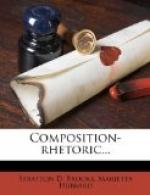10. A few nouns have two plurals differing in meaning or use [cloth, cloths, clothes; penny, pennies, pence].
+24. Case.+—Case is the relation that a noun or pronoun bears to some other word in the sentence.
Inflection of nouns or pronouns for the purpose of denoting case is termed declension. There are three cases in the English language: the nominative, the possessive, and the objective; but nouns show only two forms for each number, as the nominative and objective cases have the same form.
+25. Formation of the Possessive.+—Nouns in the singular, and those in the plural not already ending in s, form the possessive regularly by adding ’s to the nominative [finger, finger’s; geese, geese’s].
In case the plural already ends in s, the possessive case adds only the apostrophe [girls’].
A few singular nouns add only the apostrophe, when the addition of the ’s would make an unpleasant sound [Moses’].
Compound nouns form the possessive case by adding ’s to the last word. This is also the rule when two names denoting joint ownership are used: [Bradbury and Emery’s Algebra].
Notice that in the following expression the ’s is affixed to the second noun only: [My sister Martha’s book].
Names of inanimate objects usually substitute prepositional phrases to denote possession: [The hardness of the rock, not The rock’s hardness].
+26. Gender.+—Gender is the power of nouns and pronouns to denote sex. Nouns or pronouns denoting males are of the masculine gender; those denoting females are of the feminine gender; and those denoting things without animal life are of the neuter gender.
+27. Person.+—Person is the power of one class of pronouns to show whether the speaker, the person spoken to, or the person or thing spoken of is designated. According to the person denoted, the pronoun is said to be in the first, second, or third person. Nouns and many pronouns are not inflected for person, but most grammarians attribute person to them because the context of the sentence in which they are used shows what persons they represent.
+28. Constructions of Nouns.+—The following are the usual constructions of nouns:—
(a) The possessive case of the noun denotes possession.
(b) Nouns in the nominative case are used as follows:—
1. As the subject of a verb: [The western sky is all aflame]
2. As an attribute complement: [Autumn is the most gorgeous season of the year].
3. In an exclamation: [Alas, poor soul, it could not be!].
4. In direct address: [O hush thee, my baby!].
5. Absolutely: [The rain being over, the grass twinkled in the sunshine].
6. As a noun in apposition with a nominative: [Columbus; a native of Genoa, discovered America].




